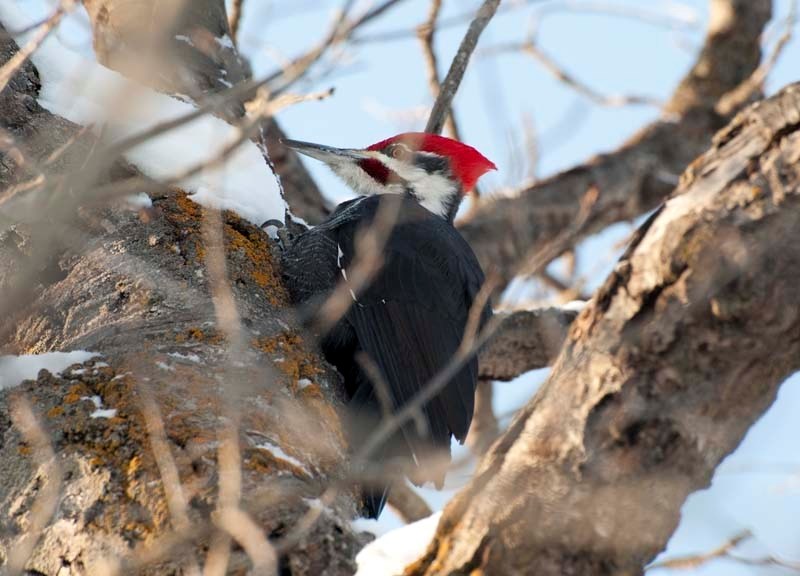It was a cold, bright day in Riverlot 56. Tromping through the snow, I heard a familiar sound – tap tap tap … tap tap tap – and immediately looked up in search of the woodpecker.
It was a cold, bright day in Riverlot 56. Tromping through the snow, I heard a familiar sound – tap tap tap … tap tap tap – and immediately looked up in search of the woodpecker.
It was a good 15 minutes before I found it – them, actually. To my delight, the distant knocker was not a miniscule downy woodpecker but its gigantic, crow-sized cousin, the pileated. What's more, there were two of them, their cherry-red Mohawks blazing in the winter sun.
One was even chiselling a foot-long crevasse in a decaying tree with its beak, huge wood chips flying with every slow, strong whack of its head.
I wondered if it got a headache in the process.
The pileated woodpecker is the biggest woodpecker in Alberta, says Jocelyn Hudon, curator of ornithology at the Royal Alberta Museum. With its bold red head-crest, black body and white-lined face, there's no other crow-sized bird around that looks like it.
In flight and at a distance, you might mistake one for a crow, as they're both black, Hudon says. Pileated woodpeckers have white patches underneath their wings, however, and move in an undulating pattern quite unlike the straight path of the crow.
You could also mistake one for an ivory-billed woodpecker, which has more white stripes on it. If you actually do see one of those, let me know, since they're supposed to be extinct.
Pileated woodpeckers also have a coloured "moustache" near their beaks, notes local ornithologist Peter Demulder. Males have red ones, while females have black ones.
Both have a shockingly loud call that seems to come out of nowhere: "KEK KEK KEK KEK KEK!" as Demulder puts it. It's a bit like a whinnying laugh.
Noisy drummers
Pileated woodpeckers have beaks that are almost as long as their heads, Hudon says. They use these to go after their favourite food – carpenter ants, which are usually found deep inside the dead core of a tree.
After tapping a tree to check if it's hollow, a pileated woodpecker will start hacking away, gripping tight with its clawed feet and using its tail as a third leg for support.
"It creates these big scars, these big holes in the sides of trees," Hudon says.
As ant galleries run the length rather than the width of trees, these holes are usually taller than they are wide. Once uncovered, the woodpecker will use its long, barbed tongue to lick up its lunch.
Local environmentalist Elke Blodgett says she's got a pileated woodpecker hammering away at the cedar siding on her home.
Woodpeckers will rapidly drum on wood as a territorial display, Hudon says. The air gap behind Blodgett's siding might make it act like a drum, making it a better signalling device for the bird.
They also dig large nest holes that are about four inches wide, Hudon says. These holes are important to other birds such as boreal owls, which use them as homes.
Despite their huge size and noisy activities, pileated woodpeckers are rather shy, Hudon says. Expect to play hide-and-seek with them as they scoot around to the opposite side of a tree trunk from you.
Need an Advil?
Ivan Schwab, an ophthalmologist at the University of California, Davis, wrote a detailed study on why the pileated woodpecker doesn't get headaches back in 2002 in the British Journal of Ophthalmology.
These woodpeckers can whack wood at up to 20 times a second and 12,000 times a day, with each hit subjecting them to a deceleration force of up to 1,200 g.
"That is the equivalent to striking a wall at 16 miles an hour – face first – each time," Schwab notes.
Several adaptations keep the bird's brain from transforming into pudding, Schwab writes. First, it has a thick skull made from spongy bone and a layer of cartilage at the base of its beak, both of which act as shock-absorbers. Wrapped around the skull is the bird's absurdly long tongue, which may act as a sort of giant bungee cord.
Next are some great reflexes. Schwab notes that a pileated woodpecker's jaw muscles contract about a millisecond before impact, creating a tight, cushioned structure that channels the force of the collision to the rear of the skull, avoiding the brain.
Last are some nictitating membranes (clear inner eyelids). High-speed cameras have shown that these slam shut a split second before impact. This likely shields the eyes from flying debris and keeps them from flying out of the bird's skull.
So if you're worried about a pileated woodpecker getting a headache, don't be – they've got it covered.
Pileated woodpecker
Name:
Dryocopus pileatus.
Appearance:
Crow-sized woodpecker with a black body, big long beak, white-streaked face and a huge red crest.
Commonly seen:
Hacking away at a tree in a big forest, searching for ants.
Occasionally confused with:
Crows, which lack the white patches under their wings.
Fun fact:
The word dryocopus comes from the Greek words for tree (drys) and cleaver (kopis). Pileatus is Latin for crested.
Wild St. Albert
Like wildlife? So do we! Every second Wednesday the Gazette profiles a reasonably common wild creature in the St. Albert region. Birds, beasts, bugs, fish … so long as it's alive and kicking, we'll feature it. <br /><br />Got a creature you'd like to see profiled? Send your suggestions to [email protected].




